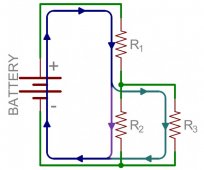If one light is on, and then I turn on the other one - will the first one glow less bright as a result?
You have a system where the two circuits are connected in parallel to the battery. Provided the battery has characteristics such that it can supply power well in excess of 14 watts then there will be no significance difference in brightness.
The issue is actually more complex since some LED lamps have built in driver circuits that provide constant energy to the LED element so variations in supply do not effect brightness, and also the battery will have an effective internal resistance.
To help understand, consider the circuit has simple lamps where the brightness depends on the voltage across each lamp. The equivalent circuit with both lamps on is as below. All batteries have an effective internal resistance, represented by R1.

The battery internal resistance, R1, the two bulbs have a resistance R2 and R3. When both lamps are on, current flows from the battery, through the battery resistance RI and then splits into equal currents through R2 and R3 ( the currents are equal because each lamp as the same resistance).
As current flows through a a resistance there is a voltage difference developed across it, the bigger the resistance, the bigger the drop.
The volt drop across R1 plus the drop across the bulb or both bulbs is equal to the battery voltage, say 12v.
The value of the battery resistance will be small, say 0.1 ohms, (this in real life would be much less), and each lamp has a resistance of 20 ohms, battery volts is 12 volts.
Using Ohms law,
current flow = voltage / resistance, and
voltage = current x resistance.
With one lamp on, R2, the current flowing from the battery is 12 / (R1 + R2), = 12/20.1= 0.597 amps. The volts across R2 is the current x resistance, 0.597 x 20 = 11.94 volts.
Now consider both lamps on. The citcuit resistance has changed a bit, R2 and R3 are now in parallel giving the effective resistance of 10 ohms.
The current flowing is 12/ ( 0.1 + 10) = 1.188 amps, this is shared between the two lamps, at 0.594 amps each.
The voltage across each lamp is, 0.594 x 20 = 11.88 volts.
In summary one lamp on has 11.94 volts applied, with both on, each has 11.88 volts applied.
This is about 0.5% difference and would be difficult to determined visually even if the lamps were identical in performance to start with.
Also the assumed battery resistance is much higher than usual, so the effect of its internal resistance would be less in practice.
So the answer to your question is, yes there will be a difference ( but with a reasonable battery, so small you wont be able to see it).
Mike